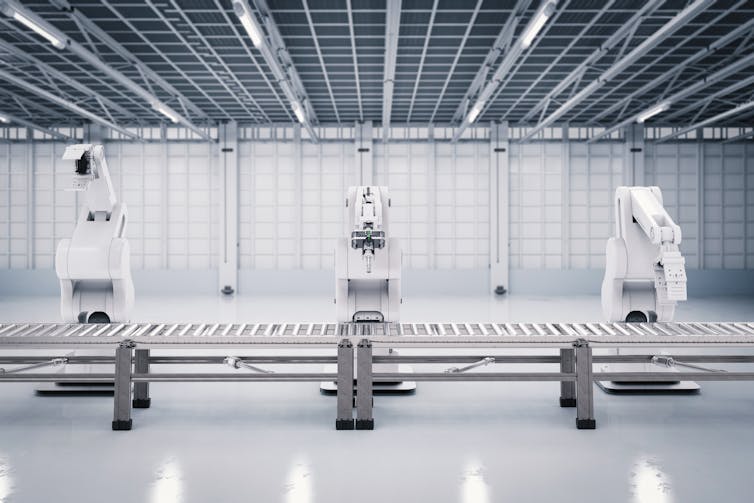Debunking the UK's productivity problem
Courtesy of Paul Lewis, University of Birmingham

Hyper-efficient. shutterstock.com
Productivity – or the UK’s lack of it – is the cause of the country’s economic woes. We have been told this by countless politicians and commentators. And the focus on Britain’s “productivity puzzle” is back in the headlines thanks to the latest budget. The UK’s latest productivity and growth forecasts have been slashed, such that the leading IFS think tank now predicts two decades of no earnings growth.
A similar story tends to be recycled every time growth forecasts change or data comparing the G7 countries or regions within the UK is released. Phrases like: “It takes a German worker four days to produce what a British one does in five.”
But how is productivity the cause of the UK’s problems and what does this statement actually mean? Unfortunately very little, because the term is used inconsistently. There are different measures of productivity and the nature of the UK’s problem depends on which one we are looking at and how it is being used.
Different definitions
At its base, productivity is a measure of output over input. The most commonly used measure of output is value-added. Literally the value added to goods and services produced in the UK, calculated as the monetary difference between what is sold and the intermediate goods used in its production.
The most commonly reported input is the number of workers or worker-hours. When combined this gives us a measure of labour productivity, calculated for each industry and aggregated for a region or the whole economy. So far, so good. However, there are some more crucial distinctions, depending upon how labour productivity is used.
If we compare the performance of the UK with other countries or that of London with other parts of the UK, this requires making the comparison at the same point in time. In this case national statistical offices use current price measures of value-added. They use prices in each country at the point of comparison, converted into a common currency (usually US dollars) and adjusted for what these can buy in each place. This is called purchasing power parity or PPP.
Hence, what we are saying when we say that London is more productive than Carlisle in the north of England or that the UK is less productive than Germany, is that the value-added at current prices produced per hour worked in those places (what economists would call nominal productivity) is different. This is likely to depend largely upon the activities that are being performed in each place.
If some highly lucrative activities are concentrated in one part of the country – say financial and professional services in London – or within a country – think of complex manufacturing across Germany – then this will strongly influence the current price productivity data. The fact that the UK lags behind other countries on this measure reflects what goods and services it produces and the prices it can command for them versus what it has to pay for intermediate inputs.
So some of what the UK produces may be attributable to the skills of workers – but clearly the UK has wider historical issues regarding the types of industry it has and the geographical diversity of its economy. It is misleading to label this a productivity problem.
Skills and efficiency
A second way that labour productivity is used is to chart its change or growth over time. This calculation involves fixing prices at some point in time and calculating the change in the quantity of output produced to give a real measure of value-added. Hence if real labour productivity is increasing at 3% per year, a country is producing 3% more actual goods and services per hour worked than it was before, independent of price changes.
It is this calculation that is reflected in the growth of the economy and increases living standards. It is often interpreted as a measure of the increasing efficiency of workers but we must bear in mind that how work is organised, what equipment workers have, how skilled and well-trained they are and how close to capacity the economy is operating will all affect this measure. Also, certain industries have greater propensity for automation, which is central to increasing productivity.
Unfortunately, since the financial crisis productivity growth across the G7 has been much lower than it was prior to it – which has raised questions regarding how realistic prior measurement was, particularly in financial services, and whether the world has entered an era of slower technological progress. The UK’s productivity fall was steeper and its rebound weaker than in comparison countries.
![]() This might be due to a number of reasons: low capital investment, poor skills, the high employment rate and low interest rates keeping inefficient companies afloat. No single explanation is currently winning the day. I would, however, urge readers to think about which measure of productivity is being used and what it means the next time we are told that the UK’s economic woes are due to poor productivity.
This might be due to a number of reasons: low capital investment, poor skills, the high employment rate and low interest rates keeping inefficient companies afloat. No single explanation is currently winning the day. I would, however, urge readers to think about which measure of productivity is being used and what it means the next time we are told that the UK’s economic woes are due to poor productivity.
Paul Lewis, Senior Lecturer in Political Economy, Birmingham Business School, University of Birmingham
This article was originally published on The Conversation. Read the original article.



